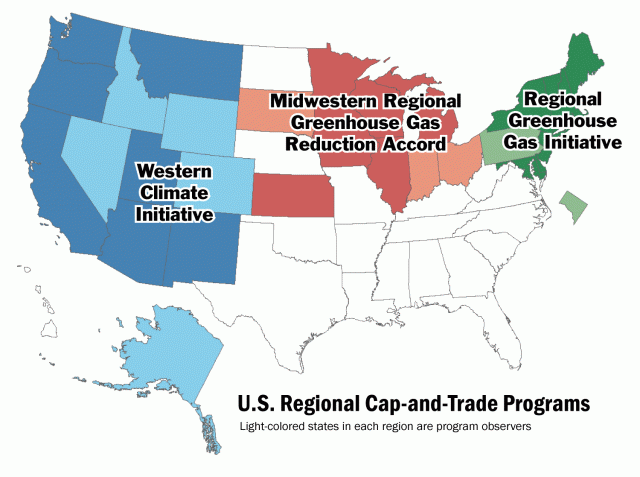Without national climate policy, regional efforts sprout up
Despite the federal government's ability to enact comprehensive climate legislation to mandate a reduction in greenhouse gas emissions (the IRA should lead to emissions reductions, but does not mandate it), much of the United States is moving forward to address climate change.
There are 3 Regional Programs committed to greenhouse gas reduction, which together represent 23 states and 4 Canadian provinces, and account for half the US population and more than a third of US greenhouse gas emissions. This too is often in flux as to specific players and actions, and we suggest these sources a great places to get up-to-date information.
US State Carbon Pricing Policies
These programs represent a widespread interest in mandatory greenhouse gas reduction across the country. As you look at the participating states and provinces, you'll see a wide diversity of politics, resource consumption, economies, and environmental concerns. Their willingness to address climate issues represents not only an acknowledgment of the problem but also an acceptance of the challenge of solving the problems while juggling economic and political considerations. Because the states are all so varied, addressing climate change at this sub-national scale represents an opportunity for the states to tailor their programs specifically to their assets and handicaps.

| Program | Participant(s) |
|---|---|
| Regional Greenhouse Gas Initiative and TCI | Maine, Vermont, New Hampshire, Massachusetts, Rhode Island, Connecticut, New York, New Jersey, Maryland, Delaware, Pennsylvania (new as of 2022 via Executive Order by Governor Wolf) |
| Midwest GHG Reduction Accord | Minnesota, Wisconsin, Michigan, Illinois, Iowa, Kansas |
| MGGRA Observer | Ohio, Indiana, South Dakota |
| Western Climate Initiative | Washington, Montana, Oregon, California, Utah, Arizona, New Mexico |
| Western Climate Initiative Observer | Idaho, Wyoming, Colorado, Nevada, Alaska |
1. Regional Greenhouse Gas Initiative (RGGI)
RGGI was the first (and currently the only) mandatory cap and trade system for the reduction of greenhouse gas emissions in the United States. It covers power plant emissions in 12 Northeastern/Mid-Atlantic states. It originally called for a 10% reduction in those emissions by 2018 and now has a goal of 30% below 2020 levels by 2030 in covered power sector emissions (any 25 MW or greater power plant).
Emission allowances are auctioned off, and the proceeds are reinvested in energy efficiency, clean energy technologies, and other related programs.
We can look at the RGGI program as a pilot program for national cap and trade, either economy-wide or just of the utility sector.
2. The Western Climate Initiative (WCI)
There are 7 states and 4 Canadian provinces participating in the WCI along with 4 Canadian provinces, 6 US states, and 6 Mexican states signed on as observers. The WCI has committed to reducing their regional greenhouse gas emissions to 15% below 2005 levels by the year 2020 and will do so by implementing a market-based cap and trade system, similar to the future plans of the Accord and the existing RGGI program. The notable difference between WCI and RGGI is that WCI is a non-profit that provides technical assistance. Each state designs its own program. Whereas RGGI is a coalition of states that trades with each other and is managed by RGGI.
